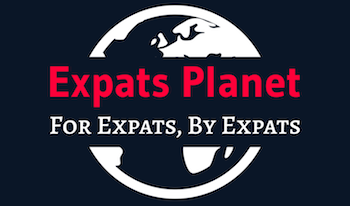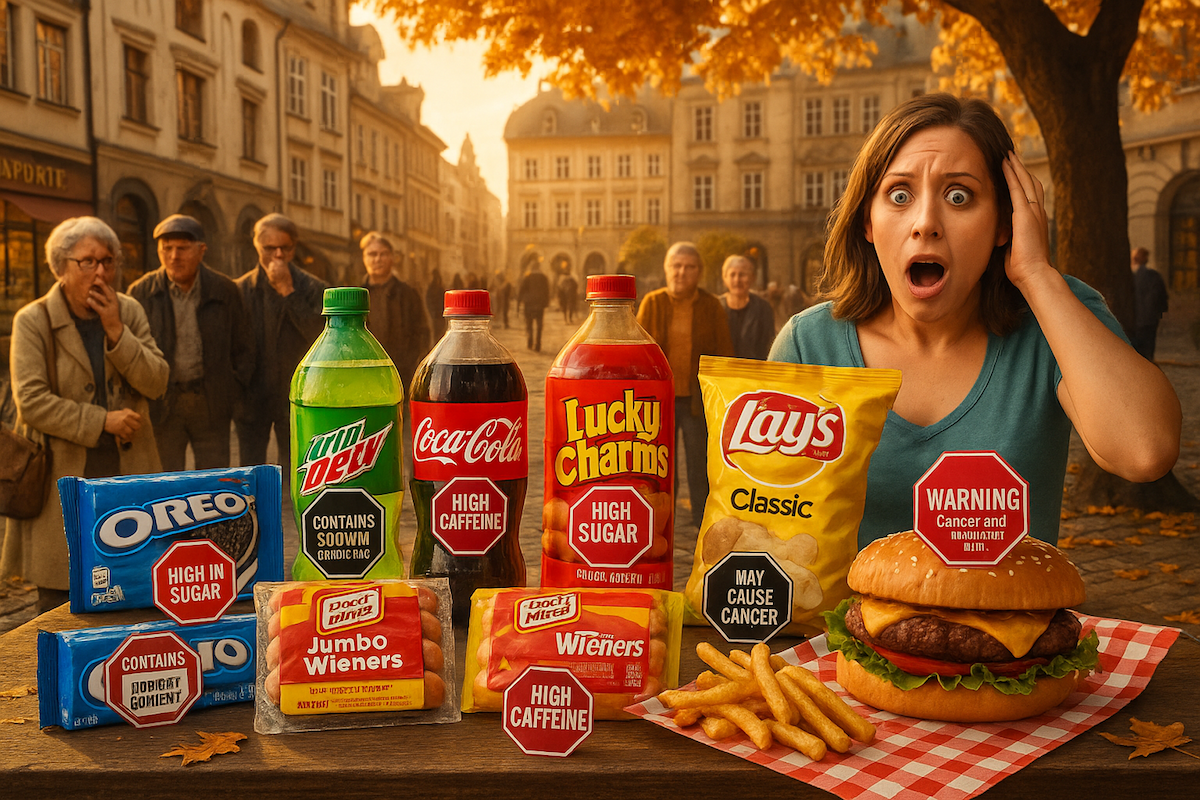Contents
The Same Foods, Two Very Different Rules
These Ingredients Are Sold in the U.S. Without Warnings but Flagged Across Europe for Health Risks
Imagine you’re standing in a Carrefour in eastern France, groggy from jet lag, just trying to find something familiar to snack on.
You grab a pack of rainbow-colored cereal, the kind you grew up with.
But right there on the front, smack in the middle of the box, is a big, bold label warning you that the contents, “May impair attention and behavior in children”.
That’s when it hit me!
Back home in the U.S., we market this stuff with cartoon leprechauns and talking animals.
In France, they slap it with the kind of warning label you’d expect to see on a cigarette pack.
Now, I’ve lived in Ukraine during the post-Soviet hangover of the late 90s.
I’ve dodged mayonnaise-laced pizza in Ukraine, squinted at Cyrillic ingredient lists of Russian imports in Georgia, and even fumbled through grocery aisles in Spain wondering whether I was buying yogurt or grout.
But I never expected a box of cereal to come with a morality clause.
But you know what the real kick in the pants is?
This isn’t even about banned substances.
These same foods are sold in both places.
The difference is, in Europe, they warn you.
In the good ol’ U.S. of A., we just smile and call it the “breakfast of champions.”
In this article, I’m pulling back the curtain on 8 everyday American foods that would legally require warning labels if they were sold across the Atlantic.
If you’ve ever handed your kid a juice pouch and thought, “well, it says all-natural,” you’ll want to keep reading.
Because what the EU says you deserve to know might make you think twice the next time you’re in the snack aisle.
1. Skittles and Sour Patch Kids
EU Label: May impair attention and behavior in children
I was in a Carrefour in France, cruising the candy aisle out of nostalgia more than hunger, when a neon-bright pack of sweets caught my eye.
It looked like a unicorn had sneezed on it.
I picked it up expecting childhood memories.
Instead, I got a label that slapped me in the face with a warning straight out of a pharmaceutical ad: “May impair attention and behavior in children.”
Turns out, in the EU, if your candy contains artificial dyes like Red 40 or Yellow 5, it doesn’t just get shelved and sold. It gets labeled like it’s a potential threat to public health.
That’s because studies in Europe linked those specific dyes to hyperactivity in kids.
So now, companies have a choice.
Either, slap the warning on the box, or change the recipe.
In France, a lot of brands quietly reformulate just to avoid the label.
But in the U.S.? Nah.
We toss these dyes into everything from cereal to toothpaste like we’re trying to win a neon arms race.
No warnings. No disclaimers.
Just “taste the rainbow” and hope your child doesn’t start climbing the walls afterward.
What to Know: If your kid’s doing flying kicks off the sofa and holding the dog hostage with a Nerf gun, it might not be bad parenting.
It might be the candy.
2. Froot Loops
EU Label: Contains synthetic dyes linked to hyperactivity
When I spotted Froot Loops in a Polish grocery store, I did a double take.
The Froot Loops box looked strangely dull.
Faded colors. No visual sugar explosion.
It didn’t even look like the same cereal. I actually thought, “Wait, is this a brand that’s not trying to hypnotize kids with neon packaging?”
That’s because in the EU, synthetic dyes like Red 40 and Yellow 5 require a warning about hyperactivity in kids.
Most brands just reformulate.
In the U.S., we leave the dyes in and say nothing.
What to Know: The brighter the cereal, the bigger the silence on what it might be doing to your kid.
3. Mountain Dew
EU Label: Contains brominated vegetable oil, linked to reproductive harm
A traveler I met in Greece once said you couldn’t find Mountain Dew anywhere back home in Norway. I thought she was exaggerating.
Then I Googled it.
Brominated vegetable oil, the same chemical used in flame retardants, was used in Mountain Dew to keep flavor from separating.
The EU banned it years ago.
The U.S.? We poured it into our sodas like it was citrus gold.
Only recently has the U.S. started phasing it out, but for years, Americans drank it with zero warnings.
What to Know: It wasn’t just a soda.
It was a lab experiment with a splash of lemon-lime.
4. Flamin’ Hot Cheetos
EU Label: May affect activity and attention in children
When I lived in Ukraine, I thought mayonnaise on pizza was the peak of culinary confusion.
Then I met Flamin’ Hot Cheetos.
I’ve watched American students inhale entire bags and clutch their stomachs like they just drank jet fuel.
The dyes in these snacks, Red 40, Yellow 6, require warning labels in the EU because of their potential impact on children’s behavior.
In the U.S., they’re packaged with cartoon flames and a grinning cheetah.
What to Know: If it burns going down and messes with your kid’s mood, the problem isn’t just the spice.
5. Capri Sun
EU Label: Contains preservatives linked to benzene formation
In Spain, I grabbed a Capri Sun expecting a sip of nostalgia while on the Camino De Santiago.
Instead, I got a cleaner version with fewer ingredients and none of the flashy “all-natural” spin.
That’s because in the EU, combining sodium benzoate with vitamin C is a chemical red flag.
The reaction can form benzene, a known carcinogen, especially when exposed to heat or light.
In the U.S., it took a wave of parental backlash before Capri Sun quietly removed sodium benzoate from some versions.
No label ever told us why…mmmm.
What to Know: If it takes a parent revolt to fix a juice pouch, it probably wasn’t all that “natural” to begin with.
6. Pop-Tarts
EU Label: Contains BHT, under review for links to cancer.
In a hostel kitchen in Dublin, I once offered a fellow traveler a Pop-Tart.
She flipped the box over, pointed to “BHT” and said, “We can’t sell this back home.”
Turns out BHT, used to keep things “fresh”, is banned or restricted in parts of Europe because of its potential links to cancer.
In the U.S., we put it in breakfast. For children!
What to Know: That warm, gooey pastry might be a childhood staple, but it comes with ingredients the EU doesn’t trust.
7. Kool-Aid
EU Label: Contains artificial colors not approved for use in food marketed to children.
You haven’t lived until you’ve watched someone in Romania try Kool-Aid for the first time and nearly recoil like they just drank Windex.
Artificial colorants that are banned in the EU are still standard in Kool-Aid packets.
The EU says they’re not safe for kids. We say “Oh yeah!”
What to Know: If it glows like a chemical spill, maybe think twice before handing it to a child.
8. Diet Sodas
EU Label: Contains aspartame, not recommended for pregnant women.
The WHO just classified aspartame as a possible carcinogen.
In France, I’ve seen bottles of diet soda with warnings that make you think twice.
In the U.S., we market it to health-conscious adults and teenagers as a smarter choice.
Smarter for whom?
What to Know: Just because it says zero calories doesn’t mean it comes with zero consequences.
The Foods Are the Same. The Warnings Are Not.
So now the real question remains:
Would you still pour your kid a glass of Kool-Aid or pack Pop-Tarts in their lunch box, if the packaging came with a warning label like a pack of cigarettes?
The difference isn’t the ingredients. It’s the honesty.
European nations aren’t perfect, but they treat food like a public health issue.
In the U.S., we treat it like branding.
Which one of these surprised you the most?
Have you or your kids eaten any of them this week?

David Peluchette is a Premium Ghostwriter/Travel and Tech Enthusiast. When David isn’t writing he enjoys traveling, learning new languages, fitness, hiking and going on long walks (did the 550 mile Camino de Santiago, not once but twice!), cooking, eating, reading and building niche websites with WordPress.

